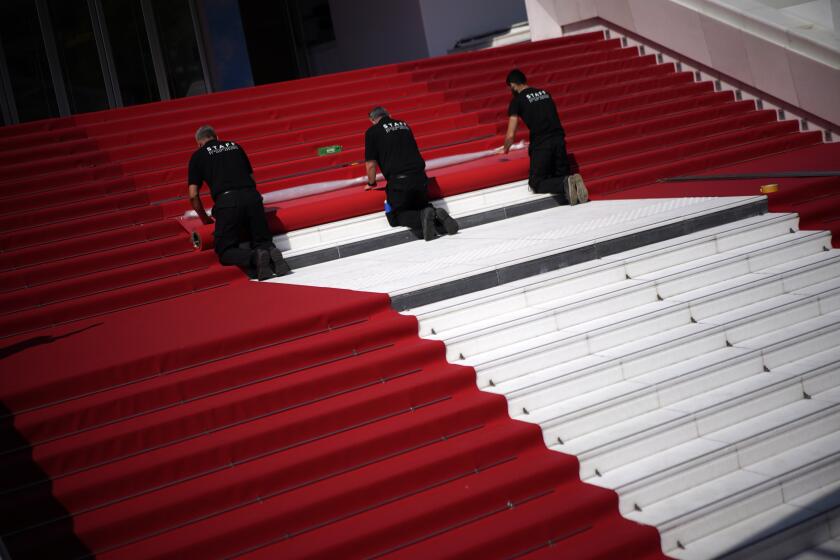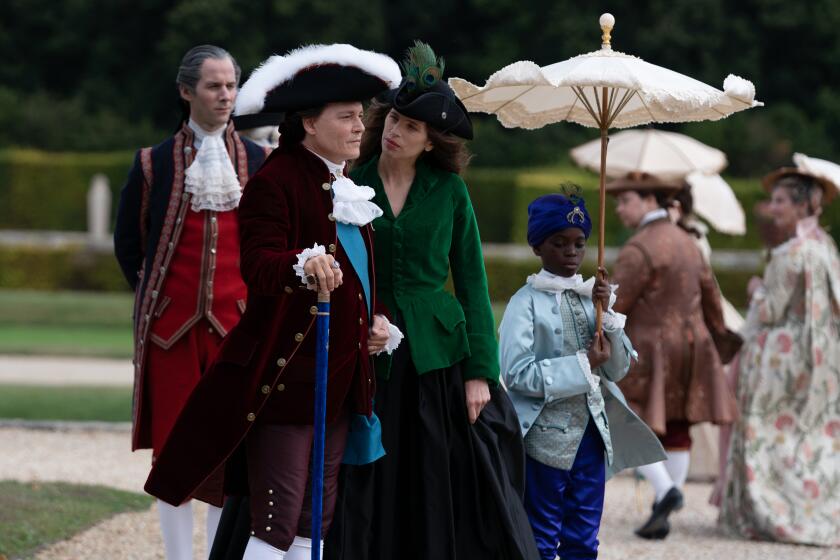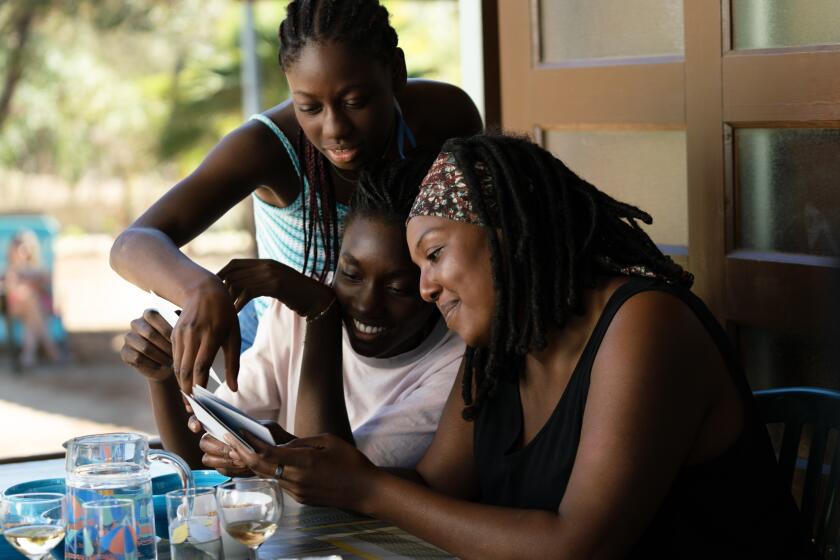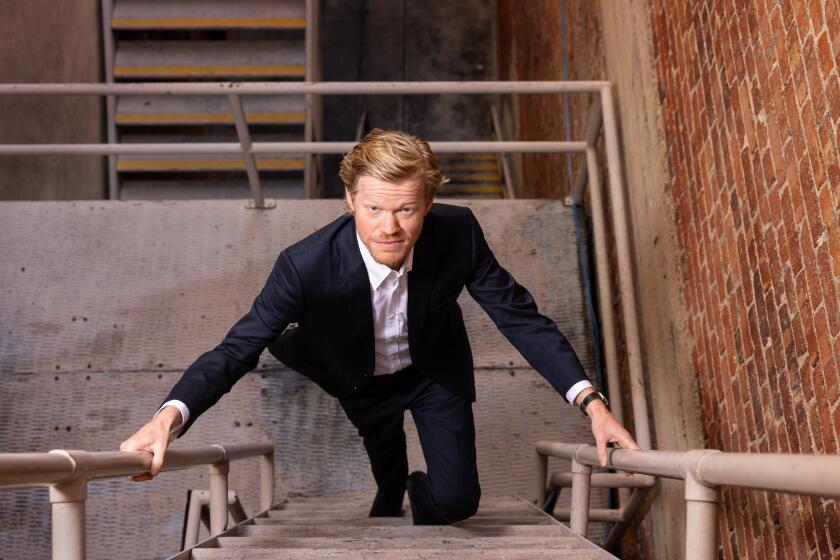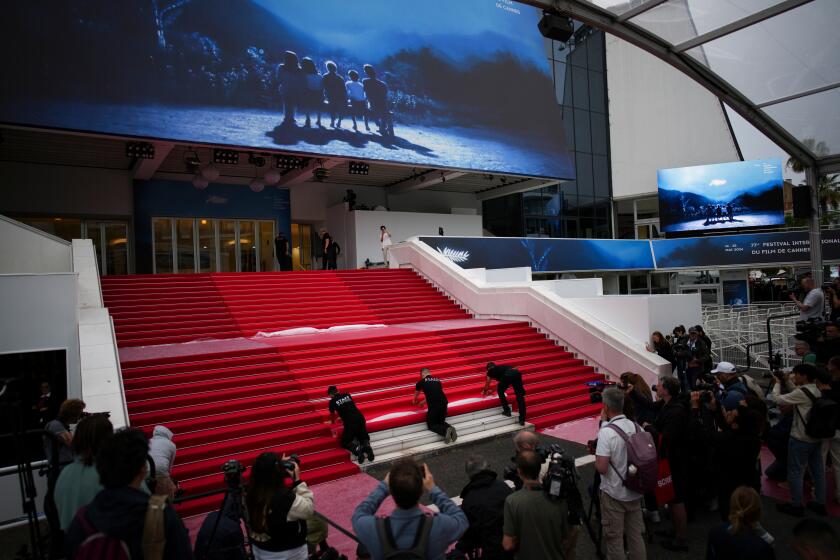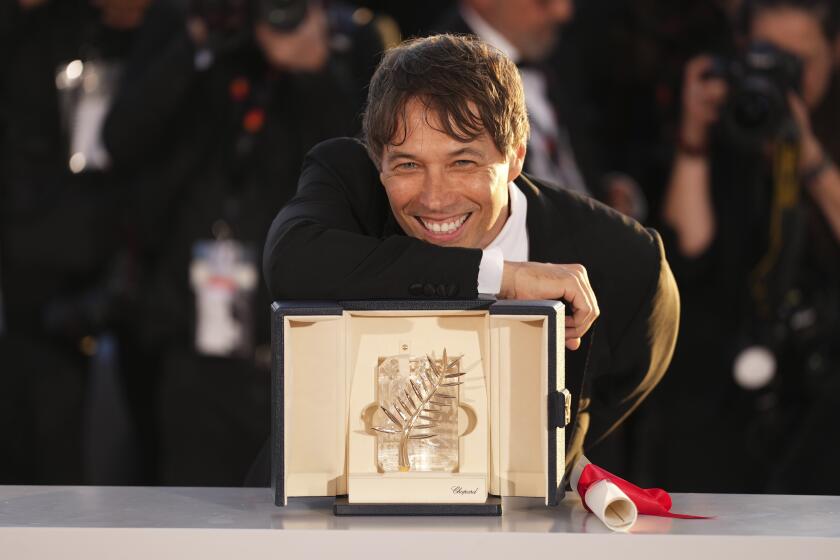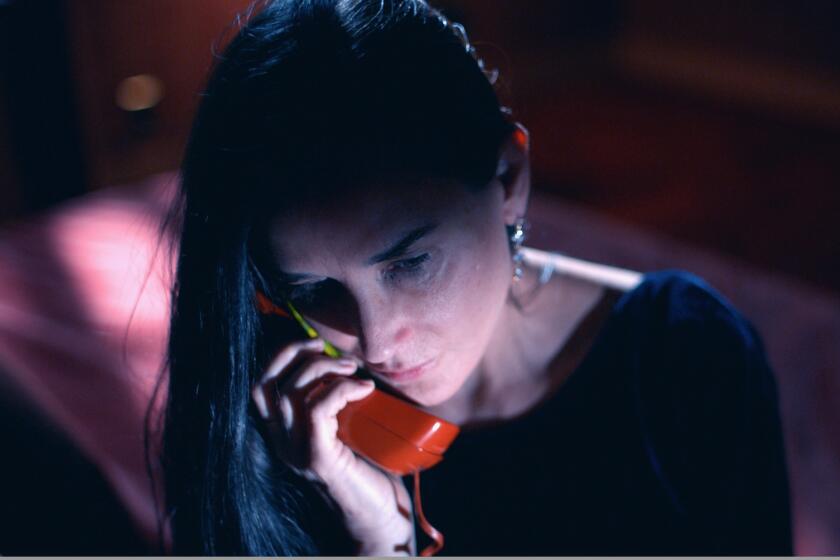‘Indiana Jones and the Dial of Destiny’: Inside the Cannes premiere
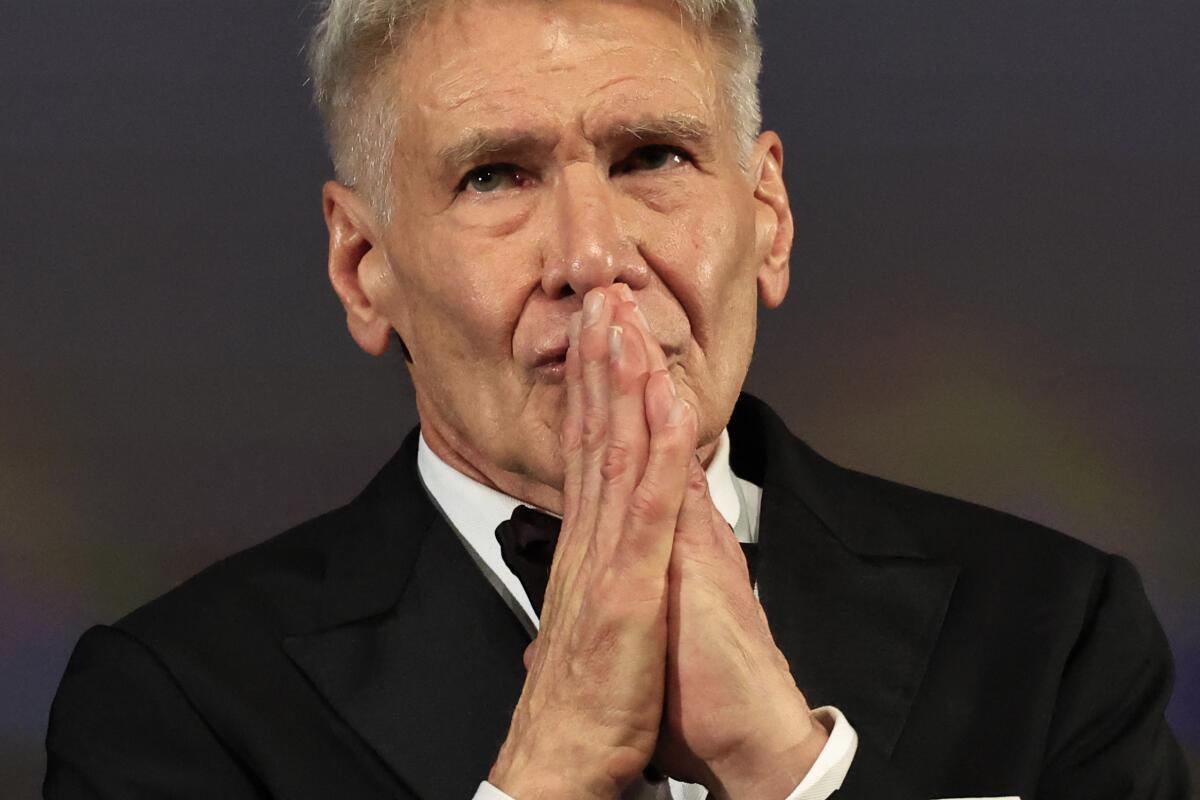
- Share via
CANNES, France — “Indiana Jones and the Dial of Destiny” premiered Thursday night at the Cannes Film Festival and Times film critic Justin Chang and culture critic Mary McNamara were there, walking the red carpet, watching Harrison Ford tear up as he accepted an unexpected honorary Palme d’Or and, most important, reuniting with one of cinema’s most iconic adventure heroes, Henry “Indiana” Jones. Who, like the rest of us, is a bit older than he was when we saw him last. That, of course, was the big question going into the fifth Indiana Jones film, 15 years after its predecessor: Are Indy, and the franchise, past their prime? Should it have been called “Indiana Jones and the Curse of the Ancient Sequel”?
Amid a writers’ strike and labor unrest, the 2023 edition features controversial stars (Johnny Depp), beloved auteurs (Martin Scorsese) and blockbuster movies (‘Indiana Jones’).
Mary McNamara: Though it will doom me among cinephiles everywhere, I confess that “Dial of Destiny” is the reason I came to Cannes. Well, that and the fact that my editor asked me to. Fly across a continent and a slew of sleep-fracturing time zones to get a first look at the return of my beloved Indy? You bet. Was I afraid I’d be disappointed? Absolutely. I saw “Indiana Jones and the Kingdom of the Crystal Skull”; I knew the risks.
Mercifully, the franchise’s rule of odds and evens held true: “Dial of Destiny” joins the pantheon of “Raiders of the Lost Ark” and “Indiana Jones and the Last Crusade,” and not just because there were so many fine and fun references to each of those films. It’s impossible to recapture the thrill of the original, but not only does “Dial” hold its own as an adventure tale, it is less a trip down memory lane than a contemplation of the dangers of nostalgia, which is pretty cheeky, when you think about it.
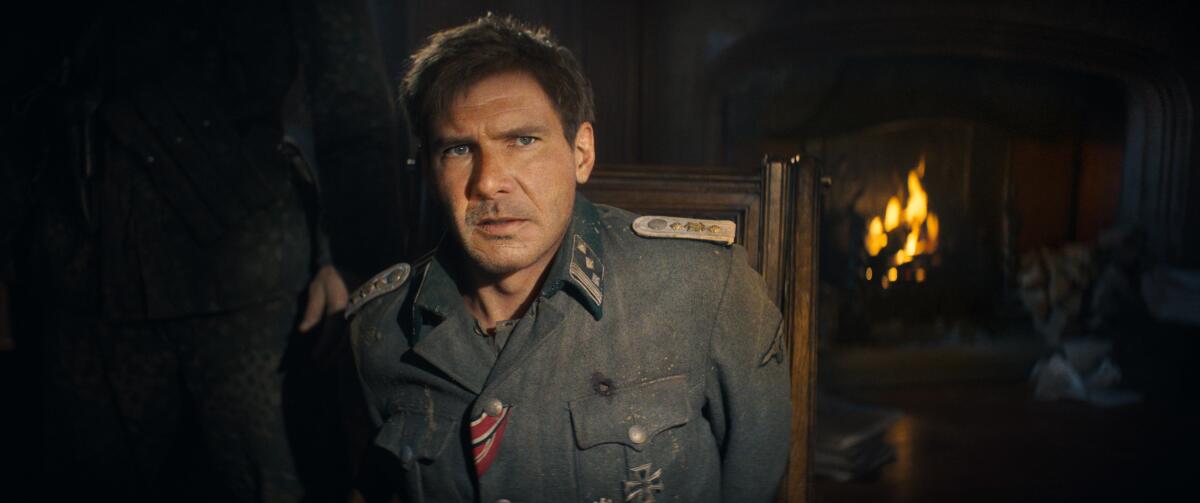
Justin Chang: Mary, if this cinephile is being honest, “Dial of Destiny” is the reason I’m most grateful you came to Cannes. (Well, that and your splendid company.) Will it doom me in your eyes to learn that I was born just two years after “Raiders of the Lost Ark” came out and somehow managed to avoid watching it until I got to college? (“Temple of Doom” and “The Last Crusade” took me even longer.) Since you are, by several rickety suspension bridges, the bigger Indiana Jones fan/expert between us, I’m happy to play the novice to your sensei as we run down what we just saw.
And what did we see? Something that, while I may not be as eager to usher it into the pantheon, certainly clears the low bar set by “Kingdom of the Crystal Skull.” I saw that fourth series entry here at Cannes back in 2008, to similarly overwhelming levels of applause and nostalgia, but the movie was an expensive mediocrity that I haven’t rewatched or thought much about since. Truth be told, I’m not sure how much I’ll think about or rewatch “Dial of Destiny,” either, though if forced to choose between the two 21st century Indy sequels, Phoebe Waller-Bridge certainly trumps a creaky blown-up fridge.
In choosing ‘Jeanne du Barry,’ which stars Depp as King Louis XV, as its opening film, the Cannes Film Festival courted controversy by claiming to ignore it.
McNamara: Screw you for being born after “Raiders of the Lost Ark,” and for not bothering to watch my biggest screen crush until you were in college. But you’re right about Waller-Bridge; as Indy’s goddaughter, Helena Shaw, she is an absolute gift. Quick with a comeback and a left hook, she is Indy’s (and Ford’s) equal in every scene and flips the trope of the woman as romantic interest/pesky hanger-on — often clad only in lingerie — that plagued the earlier movies.
Which are resurrected in the opening scenes, where a magically made-young Ford, as Indy, takes us back to World War II. The titular dial, a potentially time-traveling device created by Archimedes, is acquired, lost and acquired again. Much of the action takes place on a train — always a good sign! — and it’s shot in a way to openly evoke nostalgia. Even Mads Mikkelsen as the Nazi scientist Jürgen Voller looks a bit youth-enhanced. Indy is, if not precisely his old self, a very reasonable facsimile, punching out Nazis and pausing only to verify ancient artifacts.
The prolonged “flashback” makes the transition to 1969 both reassuring and jarring. We meet up with our hero as full-bore cranky old geezer. It’s hilarious but also depressing; director James Mangold and a team of screenwriters lean into the realities of time on myriad levels, and though we see Indy come back to life in certain ways, the film does not shy away from the fact that life is not something you come back from so much as move through.
It’s daring for a 42-year-old franchise to play with the notion that one can never really go back in time, even as it does so narratively and literally. Though all the Indiana Jones touchstones are there — antiquities, chases through winding streets in improbable vehicles, rickety bridges, even the dreaded snakes (after a fashion), there’s a weight to this film that was absent from the others, which felt quite earned to me.
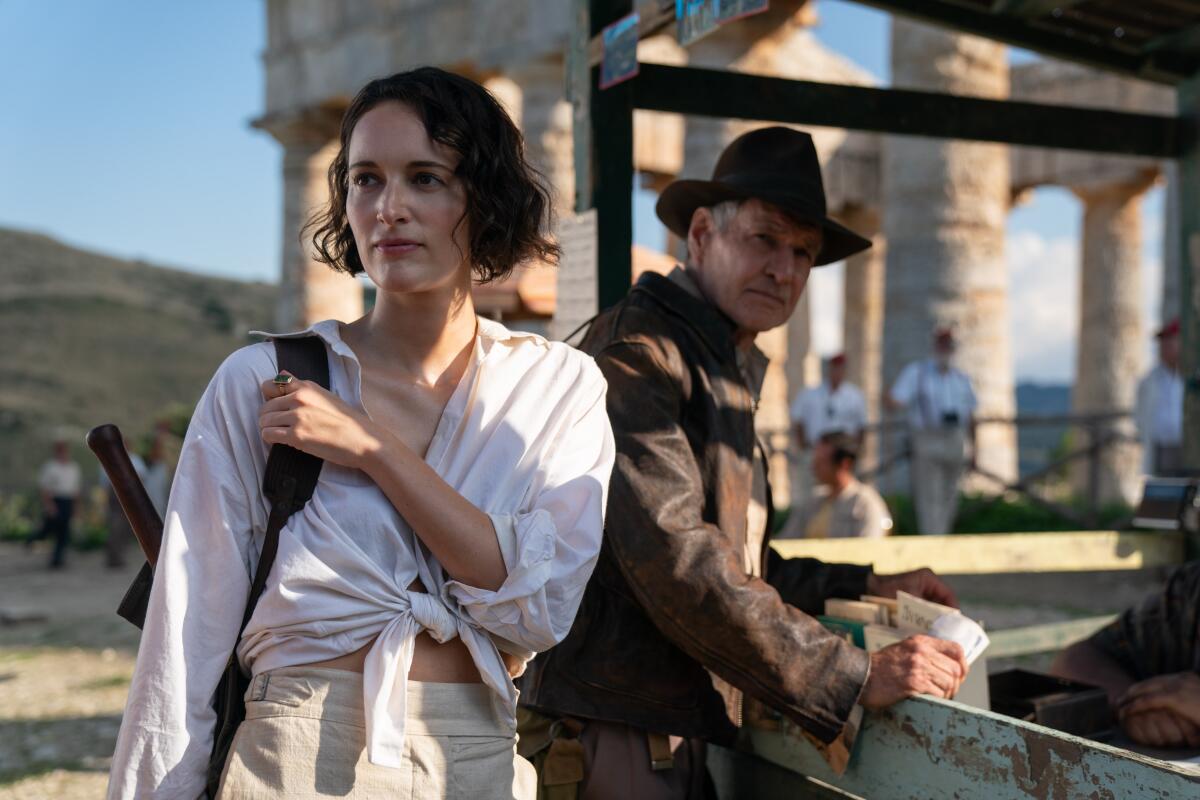
Chang: I found that World War II flashback prologue by turns fascinating, transporting and a little creepy. Ford has noted in interviews that the digital de-aging process involved artificial intelligence, which was used to pull images of his younger face from across the entire Lucasfilm archive, including from unused footage, which is why the overall effect is so seamless. Perhaps AI — a subject of much discussion in Hollywood these days — can be the villain next time around: “Indiana Jones and the Horrors of ChatGPT.” Then again, given how annoyed fans were by “Crystal Skull’s” most unwelcome pivot into science fiction, maybe better not.
The use of AI is hardly incidental to the movie’s meaning. Not unlike “Top Gun: Maverick,” the nostalgia-stoking sequel that played in the first-weekend blockbuster slot at Cannes last year, “Dial of Destiny” is subliminally invested in questions about the past and future of movies — as technological achievements, narrative exercises and communal experiences. It’s practically designed to raise the question: Can we ever go back to the durable (if variable) pleasures of the original Indiana Jones franchise, which endure not in spite of their practical effects and outmoded technologies but because of them?
We shouldn’t give away too much about the plot’s time-travel element, especially since the Disney publicity team has urged us to avoid spoilers this early in the game. (The movie doesn’t open in theaters until June 30.) But I think it’s safe and even obvious to note that there’s a level of subtext at work here. Indy’s cranky-old-geezer shtick is certainly amusing (though I do wish that Ford and Waller-Bridge, as spirited and well matched as they are, generated more laughs between them; the banter here isn’t exactly first-rate). But Indy’s yearning for the adventures of his glorious Nazi-fighting heyday — and the various personal losses he’s experienced since then — resonates in a deeper way too. It holds up a mirror to the movie audience’s own sense of loss.
I’m undoubtedly reaching here, but the movie’s much-coveted MacGuffin, which is basically a large circular clock, from certain angles reminded me of nothing so much as an old film-reel canister. And time does work in a funny way even as you’re watching the movie. About halfway through, Mary, I admit I felt I’d had nearly enough: enough propeller planes and explosives, enough globetrotting from New York to Morocco to Greece, enough Short Round-reminiscent kiddie antics (courtesy of Ethann Isidore as sidekick Teddy), though not nearly enough of a weirdly underused Antonio Banderas. The hectic action-comedy elements seemed to be running on autopilot. But then the narrative engine kicked in, and the movie found its way to a place that — again, no spoilers — felt weird, bizarre, transporting and, by the end, genuinely poignant. I’ll admit I misted up a little, and that’s largely due to Ford’s performance. He may be 80, but his star power is ageless.
It’s a strange way of life indeed at the 76th Cannes Film Festival, where rough weather, scandal-mired movies and Indiana Jones collide.
McNamara: Can we talk about the evening for a minute? As I have confessed above, Ford is my biggest, and last, screen crush, so I admit bias, but I was strangely moved when festival director Thierry Frémaux paid tribute to him before the film began, and Ford’s reaction to it. I realize it is de rigueur to heap praise on those showcased in the festival, but Frémaux followed up his gratitude to Ford’s “presence in American cinema and world cinema” with a clip reel that showed just how honestly iconic that presence has been — “Star Wars,” Jack Ryan, “Witness,” “The Fugitive,” “Blade Runner” and your (inexplicable) personal favorite “Working Girl” — the list really does go on and on. (The fact that he’s never won an Oscar is simply absurd.)
“They say when you’re about to die you see your life flash before your eyes, and I just saw my life flash before my eyes,” Ford said, quickly adding, “only some of my life,” and thanking his wife, Calista Flockhart. He choked up a bit when he thanked the audience, and filmgoers everywhere, “for giving my life purpose,” and said how grateful he was to “work with artists like James and Phoebe and even Mads.” (Laughter all around.) Then, in true Ford form, he ended with, “But I’ve got a movie you ought to see, so I’ll get out of the way.”
I realize that handing out honorary Palmes d’Or is a regular part of the festivities; Tom Cruise got one last year at the “Top Gun: Maverick” premiere. But Ford’s willingness to return, at 80, to a role he established as a young man (occasionally shirtless!) and neither shy away from the realities of nor wallow in typical shtick about age is admirable.
“Dial of Destiny” is by no means Oscar fodder — I agree there was not enough banter and, like so many films these days, it felt a bit stretched out in places. I don’t know if it will lure a new generation to the franchise if they are not familiar with it already. But as someone who was indelibly imprinted by “Raiders of the Lost Ark,” it was worth coming 6,000 miles.
Chang: First, how dare you sneer at “Working Girl,” one of the great American films of the ’80s and easily one of Ford’s best movies? I question your screen-crush devotion, Mary, if you can watch Ford’s Jack Trainer change his shirt in “Working Girl” — a scene that the festival rightly and proudly played during that montage — and not admit it belongs in the Harrison Hall of Fame.
Second, while Ford is doubtless due an honorary Oscar to go along with his honorary Palme, it would be nice indeed if he had a competitive win. He’s marvelous in “Witness,” his lone nominated performance, and he certainly deserved more awards attention for “Blade Runner,” “The Fugitive” and, yes, “Working Girl.” (Oh, and he’s scary as hell in “What Lies Beneath.”) If his quiet outpouring of emotion took a lot of us by surprise on Thursday night, it’s doubtless because we’ve come to expect gruff restraint and wry humor from this often press-shy movie star. Then again, this has been a big year and season for Ford, what with his work in the TV series “1923” and “Shrinking” and now, of course, his return to one of his signature roles.
We’ve seen “Dial of Destiny” once now, Mary, and will both doubtless see it again this summer. I’ll go in a spirit of professional obligation (but also second-viewing optimism), and I know you’ll go because you’re a fan and the movie transported you. In the meantime, I’m glad we got to experience it together in Cannes with a few thousand other filmgoers in formalwear, all of us raiders of that not-so-lost art called the movies.
More to Read
Only good movies
Get the Indie Focus newsletter, Mark Olsen's weekly guide to the world of cinema.
You may occasionally receive promotional content from the Los Angeles Times.
